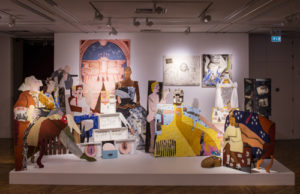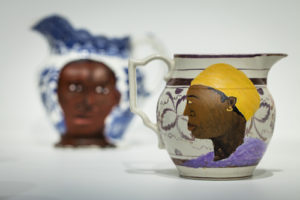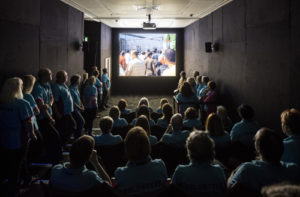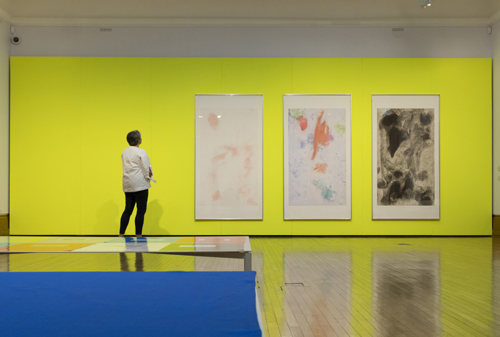On December 5, 2017, the Turner Prize jury chaired by Alex Farquharson, director of the Tate, and composed of leading critics and curators such as Dan Fox, Martin Herbert, Mason Leaver-Yap, Emily Pethick, assigns the prestigious Turner Prize 2017, to the artist, Lubaina Himid (Zanzibar, 1954), who, trained at the Wimbledon College of Art and the Royal College of Art, London, is currently Professor of Contemporary Art at the University of Central Lancashire. Interviewed by Charlotte Higgins for The Guardian, Lubaina Himid introduces her artistic practice by saying: “I want to have a conversation. My way of getting conversation going, or getting people to take action, is by drawing them in and saying: ‘You bring your baggage, your opinion, your life and I’ll bring mine – and let’s try to talk about it.’ I don’t see the point, otherwise.”
While the media underlines how Lubaina Himid is the first black woman-artist to receive the prestigious award at the age of 63, the jury of the Turner Prize motivates the choice, for the artist’s effort in “uncompromising tackling of issues including colonial history and how racism persists today”. Speaking of the African diaspora by highlighting its artistic tradition, Lubaina Himid is interested in giving voice and visibility to the realities excluded from representation. In this occasion, the artist presents four works, which underline the material and poetic aspect of her practice, such as for the works Negative Positives – The Guardian Archive, 2007-2005, in which the artist interprets the news through a series of portraits, and for the work Swallow Hard: the Lancaster Dinner Service, 2007, in which she rethinks the African decorative motifs through ceramics. If the pictorial matrix is evident in the painting Le Rodeur: The Exchange, 2016, the work A Fashionable Marriage, 1987, celebrates the African creativity, through heterogeneous materials and the intensity of chromatic tones that enrich the composition.
For the first time in history, hosted by the Ferens Art Gallery in Hull and open to the public until January 7, 2018, the Tuner Prize exhibition 2017, exhibits the works of the other finalist artists who, in line with the works of Lubaina Himid, focus on the political accent, radical and aesthetic aspects of art in relation to the participatory sphere.
The paintings by Hurvin Anderson (Birmingham, 1965) are characterized by vivid chromatic timbres, which suggest new sensitivities and perceptions from the experience of everyday life. While the pictorial training is evident in his works, such as for the scomposition of pictorial planes and in the use of colour, as in triptych, The Essentials, 2017, in the other works on display, Anderson focuses on rethinking the human figure – Peter’s Sitters II- III, 2009, and landscapes – Across the Tracks, 2013, Ascension, 2017. In both subjects, the artist’s vision focuses on making visible the reality of African communities in the United Kingdom.
The artistic practice of Andrea Büttner (Stuggart, 1972), already known for having won the Max Mara Prize for Women in 2009, assembles printing, engraving, painting and installation, often weaving texts and images with the purpose of exploring the ethical and aesthetic dimensions of art, with clear references to the work of Simone Weil, such as in the work, Simone Weil: The most dangerous disease, 1990. Through a radical accent, the artist talks about the need of communicating a social and political message through the arts, evident in the triptych iPhone Etching, 2015 – 2017, which visualizes a pictorial and feminine gesture through a series of colour prints, elaborating on the fingerprints left by the artist on her smartphone.
On this occasion, Rosalind Nashashibi (Croydon, 1973) presents two films Electrical Gaza, 2015, and Vivian’s Garden, 2017, which are composed of a documentary technique, alternated with scripts. With a focus on minimal and secondary details, the Nashashibi’s shots are understood as destabilizing images of ordinary reality, finding a new code to interpret the everyday. In Electrical Gaza, commissioned by the Imperial War Museum, the artist’s point of view is fused with that of the taxi driver and translator who accompany Nashashibi to Gaza, a city that reveals itself as a mythical, timeless place, rich in history and of culture, but impenetrable. In Vivian’s Garden, presented at Documenta 14, the artist narrates the relationship between a mother and a daughter, namely Vivian Suter and Elisabeth Wild, who emigrated to Guatemala with artistic purposes. Focusing on the matriarchal community created by them, the film looks at the different nuances of their relationship in a postcolonial context.
Overall, the 2017 edition of the Turner Prize shifts towards the sphere of ethics, reflecting on how artistic practices can work as a social action. Through a multi-cultural perspective of reality, the finalist artists seem to propose new readings of the life, by grasping sensibilities and cultures that have long remained invisible. By posing a question on how to perceive the other, the finalists of Turner Prize 2017 reveal a multi-cultural vision for the future.
 Lubaina Himid, A Fashionable Marriage, 1987, Wood cut outs (various types of wood), Acrylic paint, Newspaper, Rubber gloves, Glue, Plastic (dinner plates), Paper, Tissue, Foil, Wicker basket, Selection of books, Cardboard, Canvas, Charcoal Loaned from Hollyb ush Gardens
Lubaina Himid, A Fashionable Marriage, 1987, Wood cut outs (various types of wood), Acrylic paint, Newspaper, Rubber gloves, Glue, Plastic (dinner plates), Paper, Tissue, Foil, Wicker basket, Selection of books, Cardboard, Canvas, Charcoal Loaned from Hollyb ush Gardens
 Lubaina Himid, Swallow Hard: The Lancaster Dinner Service, 2007 Photograph: David Levene for the Guardian
Lubaina Himid, Swallow Hard: The Lancaster Dinner Service, 2007 Photograph: David Levene for the Guardian
 Hurvin Anderson, Across The Tracks, 2013 Oil and Acrylic on Canvas Loaned from Halamish Collection
Hurvin Anderson, Across The Tracks, 2013 Oil and Acrylic on Canvas Loaned from Halamish Collection
 Andrea Büttner, Fabric Wall (high visibility yellow), 2017 Stretched fabric, timber and MDF Courtesy of David Kordaresso il Wimbledon Collensky Gallery, Los Angeles
Andrea Büttner, Fabric Wall (high visibility yellow), 2017 Stretched fabric, timber and MDF Courtesy of David Kordaresso il Wimbledon Collensky Gallery, Los Angeles
 Rosalind Nashashibi, Installation view from Electrical Gaza, 2015 Photography by Emma Dalesman
Rosalind Nashashibi, Installation view from Electrical Gaza, 2015 Photography by Emma Dalesman

She is interested in the visual, verbal and textual aspects of the Modern Contemporary Arts. From historical-artistic studies at the Cà Foscari University, Venice, she has specialized in teaching and curatorial practice at the IED, Rome, and Christie’s London. The field of her research activity focuses on the theme of Light from the 1950s to current times, ontologically considering artistic, phenomenological and visual innovation aspects.







NO COMMENT